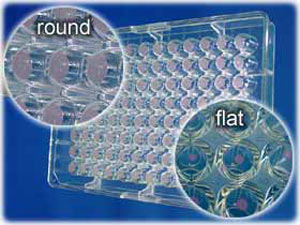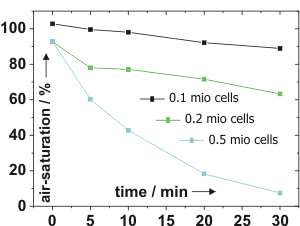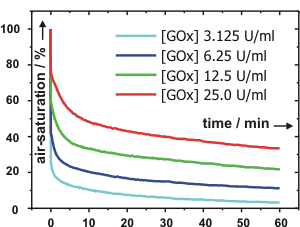Highly Parallelized Oxygen Monitoring in 96-well Microtiterplate
The OxoPlate OP96C is a beta-irradiated 96-well flat bottom microplate made of polystyrene. An oxygen sensor is integrated on the bottom of each well. The sensors can be read out in parallel from the bottom side using a commercially available fluorescence reader.
-
Ready-to-use
-
User-defined batch calibration
-
For use with conventional microplate fluorescence readers
-
High throughput screening
|
Specifications*
|
|
* in H2O dest. or oxygen-free water
|
|
Measurement range
|
0 - 30 % O2
|
|
Resolution
|
± 0.2 % O2at 0.21 % O2
±0.6 % O2 at 20.9 % O2
|
|
Precision
|
± 0.4 % O2 at 0.21 % O2
± 1.0 % O2 at 20.9 % O2
|
|
Drift
|
< 0.04 % O2 per hour (sampling interval 1 min.)
|
|
Measurement temperature range
|
from + 15 °C to + 45 °C
|
|
Response time (t90) at + 25 °C
|
< 30 sec.
|
|
Properties
|
|
Compatibility
|
Aqueous solutions, ethanol (max . 10 % v/v), methanol (max. 10 % v/v), pH 2 – 10, 20 % (v/v) DSMO, DMF, acetone, THF, or dioxane in solution. (Calibration constants have to be determined using the respective solvent instead of water.)
|
|
Cross sensitivity
|
Gaseous sulfur dioxide (SO2) and gaseous chlorine (Cl2); Changes in ionic strength
|
|
Calibration
|
Needs to be calibrated once per batch
Disposables are delivered beta-irradiated
|
|
Plate type
|
96-well flat bottom plates (Greiner Microlon® 600)
|
|
Maximum filling volume
|
400 μL
|
|
Indicator filters
|
540 nm / 650 nm
|
|
Reference filters
|
540 nm / 590 nm
|
OxoPlate
DESCRIPTION
-
Monitoring of Cell Growth
-
Enzyme Screening
-
Drug Screening
-
Homogenous Assay
-
Fast results
The OxoPlate® is a sterile polystyrene microplate in the common 96 well format with 96 integrated sensors. A sensor is immobilized on the bottom of each well. This sensor can be read out from the bottom side like depicted beneath. This can be done be a commercially available fluorescence plate reader. High accuracy is assured using two different dyes to get an internal referenced signal.
|
FEATURES
-
Calibration-FREE
-
The OxoPlate® is calibration-FREE. It contains 2 different dyes. This combination ensures its unique internal referenced signal to achieve the most exact results of your experiments.
-
Fast results The two reference dyes are immobilized in a hydrophilic matrix of the OxoPlate®. The solution can penetrate into the matrix. Therefore changes of oxygen concentration in the solution can be monitored by the sensor without significant delay.
-
Exact results Hydrophobic matrices can be reservoirs for gaseous oxygen. This is not the case for the used hydrophilic matrix. Therefore the sensor itself does not change the oxygen concentration in the well. Also, the optical sensor does not consume oxygen like oxygen electrodes.
-
Cost saving OxoPlate® is read out from the bottom side by any commercial available fluorescence plate reader which is able to work in dual wavelength mode.
-
Sterile All OxoPlates are dilivered sterile (gamma-Sterilisation).
-
Homogenous No additional reagents required.
-
Easy to use
see the OxoPlate® Short info
|
SPECIFICATIONS
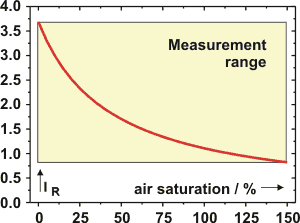
|
|
OxoPlate® OP96U / OP96F
96 well flat / round bottom microplates
|
Measurement range
|
0-150 % air-sat.
|
|
Resolution(at 37°C)
|
up to 1 % air-sat.*
|
|
Accuracy (at 37°C)
|
up to 3 % air-sat.*
|
|
Response time (t90)
(at 37°C)
|
< 30 sec
|
|
Drift per hour
|
< 1 % air-sat.*
|
|
Temperature
Range
|
from 15 to 45 °C
|
|
Indicator filters
|
540 / 650 nm
|
|
Reference filters
|
540 / 590 nm
|
|
* performance dependent on used reader
|
|
|
OxoPlate® sensors are not affected by pH, salinity, carbon dioxide (CO2 ), hydrogen sulfide (H2 S), ammonia (NH3) or amino acids. Gaseous sulfur dioxide (SO2) and gaseous chlorine (Cl2 ) interfere.
|
Detailed specification can be found in OxoPlate® User's Manual.
|
APPLICATIONS
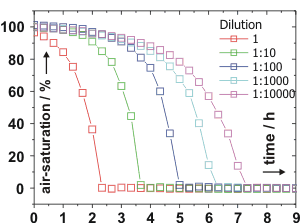
|
Screening the Toxicity of Compounds
OxoPlate® measures the toxicity of compounds at multiple concentrations. As OxoPlate® just gives you the oxygen concentration, you can measure kinetic profiles of multiple drugs. OxoPlate® is calibration-FREE, so you can compare 96 different compounds without loosing wells by using standards in every plate. In the figure on the left different concentrations of ampicillin inhibit the growth of E. coli shown by OxoPlate®.
|
|
Screening the Proliferation of Cells
OxoPlate® monitors cell growth by detecting the change of oxygen concentration. Even the low oxygen consumption of mammalian cells can be monitored easily. The figure on the right shows the growth of different numbers of HEK 293 cells at 37°C in sealed wells.
|
|
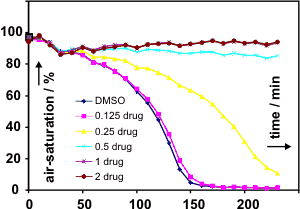
|
Monitoring of bacteria growth
One of the fundamental characteristics of the compounds tested in the process of pharmaceutical development is the MIC (minimum inhibitory concentration). This concentration can be readily determined by plotting the dissolved oxygen concentration versus time. The figure on the left/right shows a measurement of OxoPlate® to determine MIC. The MIC is equivalent to the lowest concentration that visually differs from the corresponding untreated control sample at any time point during the first 10 hours after drug treatment. This corresponds to the lowest concentration that causes the oxygen curve to differ more than 15 min in comparison to the untreated control sample to reach any given oxygen level during this time frame.
|
|
|
|
Discrimination bactericidal form bacteriostatic compounds
The OxoPlate® is a powerful tool to discriminate bactericidal form bacteriostatic compounds. As described right/left bacteriostatic compounds show a concentration-dependent delay of oxygen consumption. Oxygen levels in each well decline gradually to 0% and stay at this level. With increasing compound concentration cells grow more slowly, as indicated by the decreasing slopes of the oxygen curves.
|
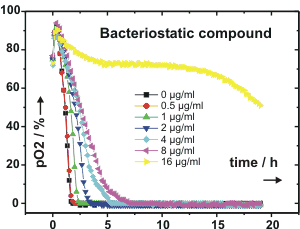
|
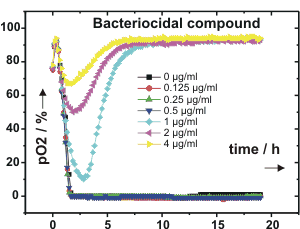
|
|
Bactericidal compounds displayed a strikingly dissimilar pattern. The effect on the initial growth rate after addition of the compound is still concentration dependent. However, in contrast to bacteriostatic compounds, the oxygen concentration increases after the drug has exerted its action. This increase is attributable to the diffusion of atmospheric oxygen into the wells after the cells have died. In summary, bacteriostatic and bactericidal compounds can be clearly discriminated. The individual oxygen depletion curves give valuable insight into the underlying growth inhibitory mechanism and the kinetics of these processes.
|
|
Screening the Enzyme reactions
OxoPlate® is the ideal tool to screen enzyme reactions which consume oxygen. With its hydrophilic matrix it has a response time below 30 sec. This makes it possible to screen even fast reactions.
The figure on the right depicts the consumption of oxygen by oxidation of glucose catalyzed by glucose oxidase (Gox). Even the fast drop at the beginning can be monitored accurately due to the low response time.
|
|
|
CALIBRATION
OxoPlate® do not need to be calibrated. However, the absolute light intensity of the used fluorescence reader is not known, so that this has to be determined by a two-point calibration of the reader.
Oxoplate® spectra
OxoPlate® manual (OP96U & OP96C)
|
MEASUREMENT
The measurement is performed by using the software of your fluorescence reader. From the measured signal the oxygen concentration can easily be calculated in units as % air saturation, Torr, hPa, mol/l, ppm, or mg/l.
|
|
